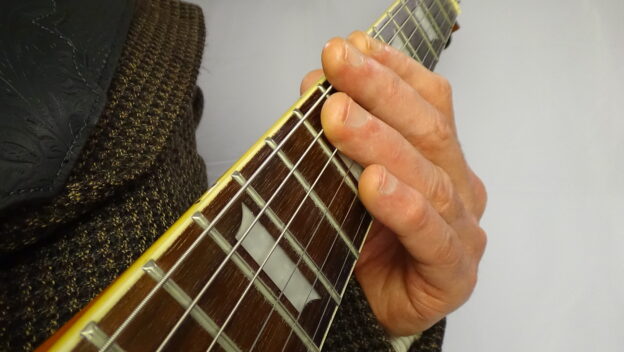By Chad Crawford, PMI Guitar Instructor
Aspiring guitarists grapple with a number of challenges in perfecting the craft. From memory failure to reluctant hands, we all struggle with predictable challenges. Some of these issues are inherent flaws in the human machine about which we can do little. Others are more within the realm of our choosing, and choose well we must if we wish to have the best possible results for our efforts.
Among the numerous assets we have to help us overcome barriers to progress, none is more potent than the power of habit. Mastering the guitar is very much a matter of cultivating good habits, both mentally and physically. Contrarily, allowing bad habits to persist will torpedo our efforts. Unfortunately, the default setting of the human machine is toward counterproductive habits. Alternatively, through exercise of our will we may choose to cultivate good habits that support musical excellence. So we must persist in a productive practice routine with various repetitive mental and physical exercises such that basic skills like chord changes, scales, and rhythm patterns become habitual. Once these things become habitual then we can then keep them habitual with only a bit of routine maintenance, and then we are free to focus on the more exciting and gratifying subtleties of making good music.
So let’s take a look at a list of techniques and strategies that will assist in cultivating good habits. These are not randomly selected tidbits, but rather key areas of fundamental knowledge and technique where I observe students struggling time after time. You can use the power of habit to help you get these fundamentals out of the way as soon as possible so that you can move on to more interesting things.
- Practice Scheduling – set up a designated place where you will practice. Keep your guitar handy on a stand and your practice materials and metronome already out or readily accessible. Make an effort to practice at the same time of day as much as possible so that it becomes a habit, where you then feel uncomfortable if you don’t get started at the appointed time.
- Fretboard Note Recognition – set aside some time each time you practice to target some area of the fretboard for note memorization. Break this formidable task into small chunks according to various schemes of dividing the fretboard such as notes along one string, one fret, etc. Make it a habit to memorize the notes along any one such scheme every week.
- Chord Changes – changing chords quickly and accurately is the most significant barrier that beginning students struggle with, and one of the more frustrating. It is one of the keys to making really satisfying music, so it is important to get this under control as quickly as possible. Many students tend to develop a habit of pausing the rhythm at chord changes and allowing themselves ample time to change chords. While this is impossible to get around at first, it quickly becomes a habit that persists long after the student is actually able to change chords without losing time. Avoid this trap by always making the effort to target the first beat of a measure for having your chord change complete. Be there on the 1 count!
- Chord Strumming Technique – while focusing on changing chords, many fall prey to a weak pick attack consisting of a half-hearted push of the pick through the strings along with a short pick stroke. Cultivate a habit of starting each down stroke at the top of the guitar body and follow through to the other side of the guitar body. Then reverse this for the upstroke. Do not push the pick through the strings as this sounds harsh and unpleasant. Perform the pick stroke with a lively snatch of the forearm, allowing the relaxed hand/wrist to follow along, and thus drag the pick quickly and lightly along the top of the strings. This is not going to happen by accident. Force it until it becomes automatic.
- Playing Scales with a Legato Feel – when practicing scale patterns always allow the previous note to run into the next note with no silence in between. This means you must maintain pressure on the previous note and snap your fingertip onto the upcoming note while simultaneously making the pick stroke for the new note. Pay attention to this important detail and keep paying attention to it until it becomes a good habit!
- Playing Phrases in Time – to get started with solo phrasing, always play your scale notes on the beat and resolve on the first beat of the underlying chord change. This may be obvious to the mind, but getting the fingers to cooperate does not happen automatically. It is very easy and very common to get absorbed with fingering notes and lose track of the timing. Make it a habit to pay attention to the beat while phrasing, and play your notes on beat.
Habits can work for you or against you. Ensure that they work for you by diligently following the tips above every time you practice. Cultivating good habits will greatly increase your rate of progress.
Copyright © 2025 Palmetto Music Institute. All Rights Reserved.


